Joe Keefe
-
- Insights: Dennis L. Bryant, Bryant’s Maritime Consulting Marine News, Nov 2013 #12
Dennis L. Bryant retired from the U.S. Coast Guard with the rank of Captain after 27 years active duty. His billets included serving on the icebreaker NORTHWIND for several years including in 1969 when it escorted the tanker MANHATTAN through the Northwest Passage (this was back in the old days, when there was real ice in the Arctic). He also spent various tours as a law specialist, including an assignment as the Coast Guard’s Law of the Sea officer. He also served a tour in the Office of International Affairs and finished his career supervising the staff charged with implementing the Oil Pollution Act of 1990 (OPA 90). After leaving the Coast Guard, he was with a major maritime law firm for 13 years. Now an independent consultant, and when not guiding his clients in navigating the complicated world of regulatory compliance, he also speaks at various forums, both domestically and internationally. His blog on recent maritime developments is always well received on the Maritime Professional web site as well as his own venue. Dennis also frequently writes maritime-related articles for various trade magazines and his work is frequently quoted by the trade press.
This month in MarineNews, we explore the current regulatory and compliance environment facing domestic maritime industry, as well as every foreign-based marine entity that hopes to do business with a country that transports 95 percent of what it consumes on the water. To that end, there is arguably no better qualified expert on the full breadth of maritime regulatory issues than is Dennis Bryant. He weighs in this month on a raft of different questions and quickly distills down to the lowest common denominator, some of the prickliest challenges facing both the commercial sectors and also the regulators themselves. We started out by asking him to comment on five specific rulemaking efforts. Listen in as he gives his unvarnished take on all of it:
Subchapter M (The Coast Guard’s effort to establish safety regulations governing the inspection, standards, and safety management systems of towing vessels):
The move to convert the U.S. towboat sector from uninspected to inspected was initiated by the towboat sector itself, which wanted to get out from under the thumb of the Occupational Safety & Health Administration (OSHA). The conversion turned out to be more complex than they envisioned. In addition, it quickly became clear that the Coast Guard lacked the manpower to conduct all these inspections in the same manner as it did with the blue-water fleet. Thus, a new paradigm has been crafted with private sector inspectors working under USCG standards. The final regulation is expected to be promulgated in 2014. Only time will tell how this new system works out.Non-Tank Vessel Response Plan regulations:
The NTVRP final rule was published on 30 September 2013. Covered vessels (nontank vessels of 400 GT and over) must submit oil spill response plans to the Coast Guard by 30 January 2014. Larger nontank vessels must enter into contracts with response providers, while smaller nontank vessels are only required to identify response providers (with the written permission of the response provider to be so identified). Many nontank vessels started the planning process several years ago based on USCG non-binding guidance. Now it’s time for everyone to join in. Experience with tank vessels has shown that proper planning reduces both the frequency and volume of oil spills.
OPA 90 Salvage Marine Fire Fighting (SMFF) rules:
The salvage and marine firefighting final rule was published on 31 December 2008. Initially, it applied only to tank vessels and implementation went smoothly. The new NTVRP rule incorporates the salvage and marine firefighting requirements, so covered nontank vessels must also plan for these issues. I foresee some difficulty here as many of the nontank vessels (particularly those at the lower end of the size limit and some of the older foreign vessels) may not have at hand all of the resources required, such as accurate, current, and detailed ship plans.
Ballast Water Regulations (IMO / USCG):
The ballast water management system process received a major boost when first New York and most recently California backed down from their requirements for unique and impossible standards. Effectively, there are now just two standards in play: the IMO standard and the US standard. The IMO standard has not officially come into force yet, but is being used for installation of equipment on new ships worldwide. The US standard, which is a more stringent version of the IMO standard, is in effect, but no BWMS has yet been certified as meeting the requirements. In the meantime, the USCG is granting 5-year waivers for vessels that utilize the IMO standard.
Transportation Workers Identification Credential (TWIC):
An unmitigated disaster. The US Congress mandated this system in 2002, in reaction to the terrorist attacks of 11 September 2001. Rather than just say that security on vessels had to be tightened and leaving it to the professionals to determine how, Congress directed a biometric solution and (in a backdoor process) mandated various details of the credential. The Transportation Security Administration (TSA), burdened with high-priority aviation security issues, did not focus sufficiently on execution of TWIC process, attempting to utilize leading-edge and untried technology.
A primary focus of DHS and the U.S. Coast Guard is to get regulations passed in a timely fashion. The Coast Guard’s Assistant Commandant for Prevention Policy, RADM Joseph Servidio, recently admitted to a backlog of some 68 projects (rulemaking efforts) that would still be in play by the end of this calendar year. Do they have too much on their plates? Is there a more efficient way to get things done?
The rulemaking process could be advanced slightly if OMB did not take so long to process draft rules. Speaking from experience, the process is complex. The Coast Guard works hard to get the rules right because it knows that those rules will have a significant impact on the regulated community.
A recent study (shown in the October edition of MarineNews) compared a particular aspect of minimally regulated commercial fishing vessels (CFVs) and their highly regulated small passenger vessels (SPVs) of 100 tons or less. The study revealed that random testing not only reduces the potential for marine casualties, but also enhances the safety of the maritime transportation industry. Is there a particular reason why one sector of the domestic marine industry is left out of the testing schemes while others are not?
The commercial fishing vessel industry has significantly more political power than does the small passenger vessel industry.
Does today’s Coast Guard have the necessary resources – and expertise – to administer to all of its regulatory responsibilities? If not, where in the U.S. government would some of those duties best be placed?
The USCG does not have the resources to fully perform its statutory missions. The only federal agency that could relieve the USCG of any of its burdens is the National Transportation Safety Board (NTSB), which could take over marine casualty investigation, but this could only occur if the NTSB were expanded.
Are there maritime/marine/transportation responsibilities best placed with the Coast Guard that currently reside elsewhere?
None that come to mind.
What, in your opinion, is the most onerous of the new regulations coming down the pike (or already here) for industry? Which one ranks as the least useful or sensible? Which will yield the greatest dividends (and original intent) for those who ultimately shaped the rules?
The biggest problem is not with the regulations; the problem is with the statutes. Congress keeps grafting new mandates onto old regimes, often in reaction to some newsworthy event. A prime example is OPA 90, which mandated double hull tankers. There is nothing wrong with double hulls, but Congress should not be mandating a particular solution. Rather, it should mandate a standard and leave it to the professionals to work out the details. At the least, Congress should have said that all new tankers must adopt either double hulls or their equivalent, leaving it to the Coast Guard to determine what is equivalent. As it is, Congress has stifled innovation. No one is going to design an alternative hull for tankers knowing that if such a ship were built it could not trade to the United States.
(As published in the November 2013 edition of Marine News - www.marinelink.com)
-
- The Jensen Marine “HandySize” Class Tug Marine News, Nov 2013 #22
Designed by Jensen Naval Architects and Marine Engineers, and built by the Great Lakes Shipyard of Cleveland, Ohio a 74-foot workboat is quickly making a name for itself; in and out of the water. The “HandySize” Class Tug was designed to fill the niche between the 2,400 to 3,200 HP market for harbor
-
- Active Regulatory Projects Marine News, Nov 2013 #8
The September hearing held by the House subcommittee on Coast Guard and Maritime Transportation centered on maritime transportation regulations and their ultimate impact on safety, security, jobs and the environment. As various industry advocates used the public venue as a vehicle to vent and for elected
-
- A Look into ABS with James Watson Marine News, Jan 2014 #12
When ABS, the global provider of maritime classification services, announced that James A. Watson had been named President and Chief Operating Officer of their Americas Division, it wasn’t hard to see why. Likewise, there were few if any other candidates for the job with as well rounded a CV, and with the
-
- SubM & EPA’s VGP Drive Green Trend on Workboats Marine News, Jun 2013 #32
Thordon Oil Free Propeller Shaft Bearings and Grease Free Rudder Bearings for Workboats produce two kinds of green. The final 2013 EPA VGP language is out. If you’ve got a Controllable Pitch Propeller and Thruster Hydraulic Fluid and other Oil-to-Sea Interfaces, including Lubrication Discharges from Paddle
-
- Brunswick’s All New 1100 IMPACT D-Collar Marine News, Jul 2016 #49
trade event held in Baltimore, MD, Brunswick unveiled its most exciting hull to date. First on board to test drive the new vessel was Marine News Editor Joe Keefe. An exhilarating 35 minute cruise revealed all of the exciting features the new vessel had to offer – whether barreling ahead at 63 KT in open waters
-
- Online and Way Ahead Marine News, Sep 2013 #98
completed the test.” Test results went electronically to the NMC database. And the cost? Just $100. More than three years ago, MarineNews editor Joe Keefe was one of the first students to experience the CMES’ LMS system. During his journey to attain STCW credentials for his “continuation status” USCG
-
- Bulk Shipping: Economics 101 Maritime Logistics Professional, Mar/Apr 2018 #40
.Peter H. Stephaich is Chairman and CEO of Blue Danube Incorporated and Campbell Transportation Company. In a September 2017 interview, MarineNews editor Joe Keefe asked, “What will it take for freight rates to improve on the inland rivers?” Stephaich answered simply, “Economics 101, demand and supply. We either
-
- Big City Fireboats Marine News, Apr 2020 #20
. Local officials wanted smaller boats with flexible capacities, firefighting and hazmat response, for example.In Marine News’ December 2019 issue, Joe Keefe described how this shift in the fireboat market has continued and grown. The Fire Department in Rochester, N.Y., for example, after five years of
-
- Cruising: Small is Beautiful Maritime Logistics Professional, Jan/Feb 2019 #24
of larger cruise vessels in markets such as the Galapagos, actually can do passengers a disservice. Maritime Logistics Professional magazine Editor Joe Keefe, while not necessarily an experienced cruise veteran, nevertheless took such a trip in the not too distant past. What he had to say was illuminating
-
- Innovative Boats: Marine News' Best of 2016 Marine News, Dec 2016 #42
its most exciting hull to date – one that can now be ordered with an aluminum hull. First on board to test drive the new vessel was Marine News Editor Joe Keefe. An exhilarating 35 minute cruise revealed all of the exciting features the new vessel had to offer – whether barreling ahead at 63 KT in open waters
-
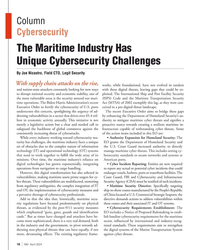 )
April 2024 - Marine News page: 18
)
April 2024 - Marine News page: 18Column Cybersecurity The Maritime Industry Has Unique Cybersecurity Challenges By Joe Nicastro, Field CTO, Legit Security With supply chain attacks on the rise, works, while foundational, have not evolved in tandem and nation-state attackers constantly looking for new ways with these digital threats
-
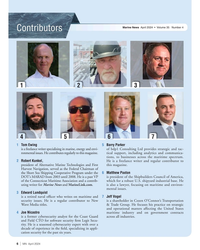 )
April 2024 - Marine News page: 6
)
April 2024 - Marine News page: 6Transportation Wave Media titles. & Trade Group. He focuses his practice on strategic and operational matters affecting the United States 4 Joe Nicastro maritime industry and on government contracts is a former cybersecurity analyst for the Coast Guard across all industries. and Field CTO
-
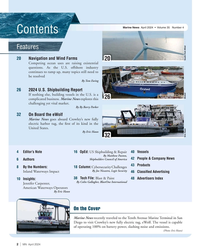 )
April 2024 - Marine News page: 2
)
April 2024 - Marine News page: 2, 42 People & Company News Shipbuilders Council of America 6 Authors 43 Products 8 By the Numbers: 18 Column: Cybersecurity Challenges By Joe Nicastro, Legit Security Inland Waterways Impact 46 Classi? ed Advertising 10 Insights: 38 Tech File: Blast & Paint 48 Advertiser
-
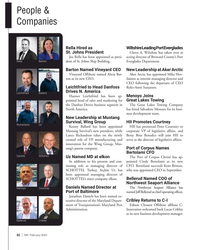 )
February 2024 - Marine News page: 42
)
February 2024 - Marine News page: 42People & Companies Rella Hired as Wiltshire Leading Port Everglades St. Johns President Glenn A. Wiltshire has taken over as Joe Rella has been appointed as presi- acting director of Broward County’s Port Rella Barton dent of St. Johns Ship Building. Everglades Department. Barton Named Vineyard CEO New
-
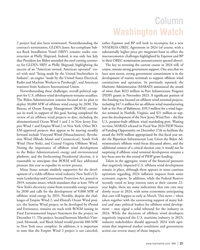 )
February 2024 - Marine News page: 21
)
February 2024 - Marine News page: 21to offset the struction at Philly Shipyard. Indeed, it was only last July macroeconomic challenges highlighted by Equinor and BP that President Joe Biden attended the steel cutting ceremo- in their OREC termination announcement quoted above). ny for GLDD’s SRIV at Philly Shipyard, highlighting the
-
 )
November 2023 - Marine News page: 49
)
November 2023 - Marine News page: 49tunnel unit bow at Weeks Marine, Inc.,” said ESG’s len (ESG 256), built by ESG and de- thruster, two Hyundai main genera- CEO and chairman of the board, Joey livered in 2017. tors, GE 6L250 MDC IMOIII/EPA D’Isernia. “The R.B. Weeks joins an Like the Magdalen, R.B. Weeks Tier 4 / Hyundai auxiliary generator
-
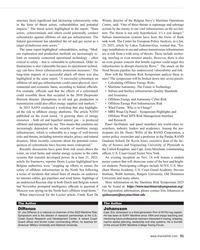 )
September 2023 - Maritime Reporter and Engineering News page: 51
)
September 2023 - Maritime Reporter and Engineering News page: 51at When interviewed for the Loctier article, Cmdr. Kurt De [email protected] The Author The Author DiRenzo Johansson Dr. Joe DiRenzo is a national co-chairman of the 2023 Maritime Risk Capt. Eric Johansson is a third-generation Port of NY/NJ tug captain. Symposium and is
-
 )
September 2023 - Maritime Reporter and Engineering News page: 50
)
September 2023 - Maritime Reporter and Engineering News page: 50Risk Symposium Managing Impacts of Supply Chain Disruptors, Renewable Energy, Emerging Technology on the Maritime Transportation System (MTS) By Dr. Joe DiRenzo and Capt. Eric Johansson he 2023 Maritime Risk Sympo- sium (MRS) will be held Nov. 14- 16, 2023, as an in-person event, Thosted by Maritime
-
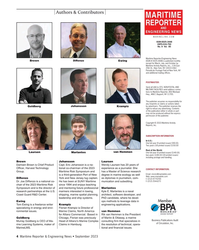 )
September 2023 - Maritime Reporter and Engineering News page: 4
)
September 2023 - Maritime Reporter and Engineering News page: 4as well Web: www.marinelink.com DiRenzo York and New Jersey tug captain. as diplomas in journalism, com- t: (212) 477-6700 f: (212) 254-6271 Dr. Joe DiRenzo is a national co- He has been at SUNY Maritime munication and subediting. chair of the 2023 Maritime Risk since 1994 and enjoys teaching Symposium
-
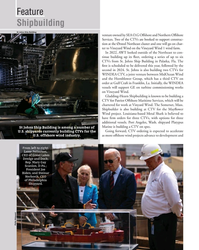 )
August 2023 - Marine News page: 36
)
August 2023 - Marine News page: 36projects advance to development and From left to right: Lasse Petterson, CEO of Great Lakes Dredge and Dock; Rep. Mary Gay Scanlon, D-Pa.; President Joe Biden; and Steinar Nerbovik, CEO of Philadelphia Shipyard. Philly Shipyar
-
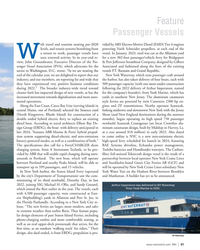 )
February 2023 - Marine News page: 31
)
February 2023 - Marine News page: 31? eet earlier in the year. The vessels, each with 4,500 passenger capacity, were constructed at East- ern Shipbuilding’s yards in Allanton and Port St. Joe, in the Florida Panhandle. According to a New York City re- lease, “The new ferries are larger, more modern, and safer in extreme weather than earlier
-
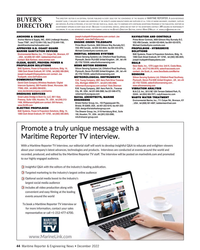 )
December 2022 - Maritime Reporter and Engineering News page: 44
)
December 2022 - Maritime Reporter and Engineering News page: 44ARK ALLEY AT MOMALLEY MARINELINK COM . I B ’ D S , M O’M @ . ANCHORS & CHAINS [email protected] contact: Joe NAVIGATION AND CONTROLS Hudspeth, www.GetToZero.com Anchor Marine & Supply, INC., 6545 Lindbergh Houston, Prime Mover Controls, 3600 Gilmore Way
-
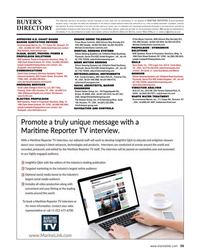 )
November 2022 - Maritime Reporter and Engineering News page: 59
)
November 2022 - Maritime Reporter and Engineering News page: 59Street Endicott, NY 13760 , tel:(360) 306-2844, SEALS Silicon Sensing Systems Ltd, Clittaford Road Southway, [email protected] contact: Joe Seco Seals, Inc., 1370 Logan Ave. Unit K, Costa Mesa, Plymouth, Devon PL6 6DE United Kingdom , UK , tel:+44 Hudspeth, www.GetToZero.com CA , USA
-
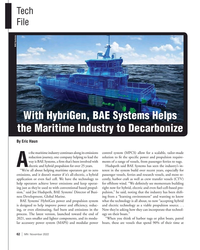 )
November 2022 - Marine News page: 62
)
November 2022 - Marine News page: 62see momentum building ing just as they’re used to with conventional based propul- right now for hybrid, electric and even fuel-cell-based pro- sion,” said Joe Hudspeth, BAE Systems’ Director of Busi- pulsion,” he said, noting that the industry has been shift- ness Development, Global Marine. ing from a “learning
-
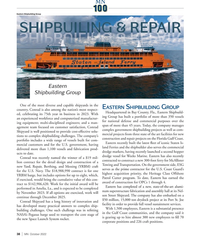 )
October 2022 - Marine News page: 38
)
October 2022 - Marine News page: 38embarked on a continue through December 2025. Conrad Shipyard has a long history of innovation and $50 million, 15,000 ton drydock project at its Port St. Joe facility in order to provide full vessel sustainment services. has developed many practical answers to complex ship- With 1,500 employees, Eastern
-
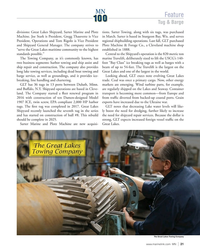 )
October 2022 - Marine News page: 21
)
October 2022 - Marine News page: 21MN Feature Tug & Barge divisions: Great Lakes Shipyard, Sarter Marine and Plotz tions. Sarter Towing, along with six tugs, was purchased Machine. Joe Stark is President, Gregg Thauvette is Vice in March. Sarter is based in Sturgeon Bay, Wis. and serves President, Operations and Tom Rigolo is Vice
-
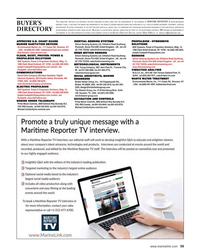 )
September 2022 - Maritime Reporter and Engineering News page: 59
)
September 2022 - Maritime Reporter and Engineering News page: 591098 Clark Street Endicott, NY 13760 , tel:(360) 306-2844, (0) 1752 723330, [email protected] , [email protected] contact: Joe www.siliconsensing.com R.M. Young Company, 2801 Aero Park Dr., Traverse City, MI , tel:231-946-3980, fax:231-946-4772, Hudspeth, www.GetToZero
-
 )
September 2022 - Maritime Reporter and Engineering News page: 41
)
September 2022 - Maritime Reporter and Engineering News page: 41at all costs to accepting it as a background for the Symposium, either in-person or virtually. The Author The Author DiRenzo Hummel Dr. Joe DiRenzo is the director of research Dr. John Hummel is the Program Lead partnerships at the Coast Guard Research for Integrated Resiliency Analyses
-
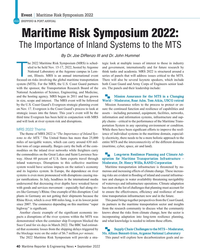 )
September 2022 - Maritime Reporter and Engineering News page: 40
)
September 2022 - Maritime Reporter and Engineering News page: 40Event | Maritime Risk Symposium 2022 2022 SHIPPING & PORT ANNUAL Maritime Risk Symposium 2022: The Importance of Inland Systems to the MTS By Dr. Joe DiRenzo III and Dr. John Hummel he 2022 Maritime Risk Symposium (MRS) is sched- tegic look at multiple issues of interest to those in industry uled
-
 )
September 2022 - Maritime Reporter and Engineering News page: 4
)
September 2022 - Maritime Reporter and Engineering News page: 4is the Program van Hemmen CONTACT INFORMATION: DiRenzo Lead for Integrated Resiliency Rik van Hemmen is the President Email: [email protected] Dr. Joe DiRenzo is the direc- Analyses in the Decision and of Martin & Ottaway, a marine Web: www.marinelink.com tor of research partnerships at Infrastructure
-
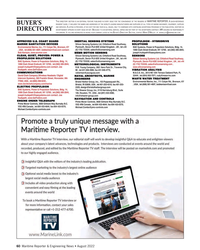 )
August 2022 - Maritime Reporter and Engineering News page: 60
)
August 2022 - Maritime Reporter and Engineering News page: 601098 Clark Street Endicott, NY 13760 , tel:(360) 306-2844, (0) 1752 723330, [email protected] , [email protected] contact: Joe www.siliconsensing.com R.M. Young Company, 2801 Aero Park Dr., Traverse City, MI , tel:231-946-3980, fax:231-946-4772, Hudspeth, www.GetToZero
-
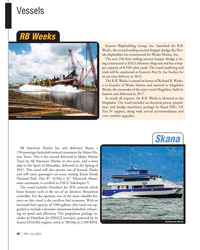 )
July 2022 - Marine News page: 39
)
July 2022 - Marine News page: 39at ESG’s Allanton Shipyard and has a hop- per capacity of 8,550 cubic yards. The vessel out? tting and trials will be conducted at Eastern’s Port St. Joe Facility for an on-time delivery in 2023. The R.B. Weeks is named in honor of Richard B. Weeks, a co-founder of Weeks Marine and married to Magdalen
-
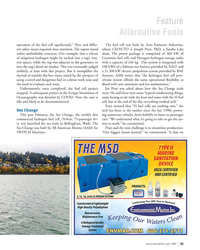 )
July 2022 - Marine News page: 34
)
July 2022 - Marine News page: 34? exibility as the need to evaluate each issue. diesel with zero emissions and less maintenance.” Unfortunately, once completed, the fuel cell project Joe Pratt was asked about how the Sea Change trials stopped. A subsequent project at the Scripps Institution of went. He said there were some “typical
-
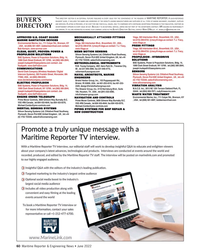 )
June 2022 - Maritime Reporter and Engineering News page: 60
)
June 2022 - Maritime Reporter and Engineering News page: 60, (0) 1752 723330, [email protected] SOLUTIONS BAE Systems, Power & Propulsion Solutions, Bldg. 14, [email protected] contact: Joe METEOROLOGICAL INSTRUMENTS Hudspeth, www.GetToZero.com 1098 Clark Street Endicott, NY 13760 , tel:(360) 306-2844, R.M. Young Company, 2801 Aero
